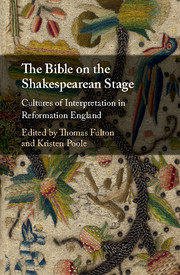Book contents
- The Bible on the Shakespearean Stage
- The Bible on the Shakespearean Stage
- Copyright page
- Dedication
- Contents
- Illustrations
- Notes on Contributors
- Acknowledgments
- A Note on the Text
- Introduction Popular Hermeneutics in Shakespeare’s London
- I Europe, England:
- II Stagings:
- III Interplay:
- IV Enactment:
- Afterword Shakespeare’s Biblical Virtues
- Notes
- Index
Introduction - Popular Hermeneutics in Shakespeare’s London
Published online by Cambridge University Press: 17 April 2018
- The Bible on the Shakespearean Stage
- The Bible on the Shakespearean Stage
- Copyright page
- Dedication
- Contents
- Illustrations
- Notes on Contributors
- Acknowledgments
- A Note on the Text
- Introduction Popular Hermeneutics in Shakespeare’s London
- I Europe, England:
- II Stagings:
- III Interplay:
- IV Enactment:
- Afterword Shakespeare’s Biblical Virtues
- Notes
- Index
Summary
- Type
- Chapter
- Information
- The Bible on the Shakespearean StageCultures of Interpretation in Reformation England, pp. 1 - 14Publisher: Cambridge University PressPrint publication year: 2018



